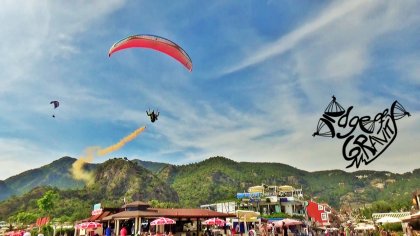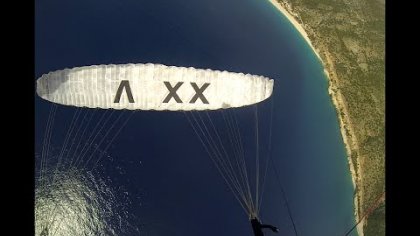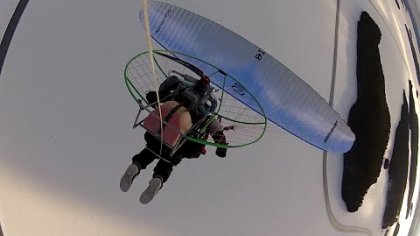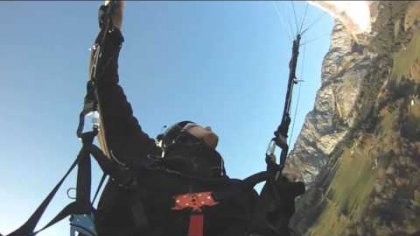19 years ago
Description:
This manoeuvre was invented by Raul Rodriguez in 1999. The name comes from the name of his team, the Safety Acro Team. Actually it’s a kind of spiral, wherein the center of the rotation is between the glider and the pilot. It means, the glider turns forward, (positive) while the pilot turns backward (negative). The sinking rate is pretty low, somewhere between 2-6 m/s, depends on the glider and the execution of the manoeuvre.
The SAT is the basis of some other manoeuvres such as Asymmetric SAT, Tumbling and Rythmic SAT.
Enter:
If you want to do a SAT to the right, grab the left riser, push it out as much as you can, and shift all your weight to the right. It’s called SAT position. Take one or two wraps on the right brake (If your brakelines are long, it’s more comfortable to take two, because then you don’t have to pull the brake so deep, however I advise to do the first attempts only with one wrap, because there’s less risk to pull an unintended Spin. Probably you’ll be able to enter the SAT like this, but maybe you cannot turn it up very steep). Start to pull down the brake gradually, just like as you lead in a Deep Spiral but dynamically. After about 3/4-1 turn, as the leading edge starts to be facing the ground and the brake is getting heavier, pull the brake even further just a little bit faster (but still gradually!), around to your nipple (but of course it depends on the glider’s type and the brake setting). Now the center of the rotation is changed, the right side of the wing will be higher and you’ll lean down to the left in your harness. Keep yourself in SAT position by your left hand, don’t let yourself slide down. You’ll see there’s almost silence in the SAT, you are turning slowly, unlike in Deep Spiral.
Once you’re in, you can adjust the steepness (the angle between the leading edge and the horizon) and the speed of the rotation by the right brake. As you add more brake, the leading edge will be steeper according to the horizon, and it decreases the speed of the rotation, the sink rate and the G-Force also. But be careful, do not pull a Coconut Spin unintentionally. The maximum angle of the SAT, where the profile of canopy is still unbroked is various from glider to glider.
In a stable SAT, you can release your left hand, but keep yourself in SAT position (One-Handed SAT).
From my experience, it’s easier to SAT low DHV rated gliders (like DHV 1, 1-2), because on these types you have much more time to enter (you don’t have to be so precise) and due to the lower Spin tendency, it’s also much safer. I advise to learn this manoeuvre on one of these gliders, and once you did some successful SATs, it will be pretty easy to do it on other gliders.
Anyway, there are some gliders, especially older types, but also some of the newer designs, which are not able to do the SAT. Make sure you don’t fly with one of these wings before you try this trick.
Exit:
Just center your body and release the right brake quickly. The movement will transform into a simple Spiral Dive. Lead it out gradually by few turns. Usually the lower wingtip collapses for a moment at the exit, but it doesn’t matter. With some gliders, you can prevent it by releasing the brake a bit slower, or use some outer brake at the exit.
Dangers!
Like in almost all acro manoeuvres, the most important thing is the right timing.
If you try to lead in too early, the glider won’t have enough energy to enter the SAT (too big angle between the leading edge and the horizon), and as you pull the brake very hard you’ll end up in a dynamic Spin and you can easily get a riser twist, big cravattes etc. Please read carefully the dangers of Spin, especially riser twisting. Anyway, if it happens, Full Stall is the safest way to return normal flight. Before you try this manoeuvre, be very confident with Full Stalls!
If you don’t brake enough or try to enter too late, the glider will have too much energy to SAT and you will enter a very dynamic Spiral Dive. In this case you won’t be able to enter the SAT anymore, even if you pull down the brake really hard, so immediately release it and lead out the Spiral (Ok, it’s not impossible with some damped gliders, but it’s better to exit anyway).
If you leave your body in SAT position at the exit (still lean to the right pretty hard), you may enter a Nose Down Spiral. This kind of spiral is very fast and stable and it doesn’t recover for itself if the pilot doesn't do anything!
Please read very carefully the dangers of Nose Down Spiral and before you try this trick, learn how to exit from fast descending Spiral Dives.







Latest Comments
I have a dune S and i really want to do the SAT mpretty soon, it will be my first, so does anyone have any other dune and can give some advise that i should consider..?
thanx, Jp
I've tried a SAT with my new Synergy2. I think I didn't pulled the brake at the right moment, because after entering in SAT, the lower half of the wing was in a way of front-stall situasion. I've felt that the pressure on the breaked side is very high and after a few turns I've released the brake and exited. What do you think where was the problem in the entering?
Zoli
I'm interested in experiences with gliders which can't SAT.
I had my first experience this weekend. I've tried a Nova Syntax (DHV1-2, low end), size was M (85-110kg), so a bit large for me (my takeoff weight was about 90kgs.
It's a perfect glider for beginners as it is very stable.
First I tried some wingovers, but the glider is not dinamic and my weight wasn't enough.
So I took one wrap on the brakes, grabd the riser and started the enter into SAT. It took a while to reach the point where I was thinking to have enough energy for a SAT. As I pulled the break it just entered into a nose down spiral with the non-breaked side of the glider was flying in front stall situation :) It was table but not a SAT.
Than I tried ti with 2 wraps, and with aggressive weightshift. The glider did the SAT, but went further and made a spin. It was easily manageable and a good experience.
I didn't had more height to test, so I stoped. I think it's possible to SAT this glider, just takes precise timing and some more practice... Anyway it wasn't my size.
Others expereince with higher rated gliders?
Lupus
Hi! Did anybody ever try a SAT on a Airwave Sport2?
Hi!
It is possible to enter the SAT without grabbing and pushing the riser. It only helps you to be able to use your weight-shift more effective (which leads to a nice SAT entry) and to keep yourself in SAT position after the movement starts. I think the extra tension on the riser also helps to keep open the outside wingtip.
Good luck!
Hy! I've made my first SAT with a Swing Mistral 2 without the intention to do a SAT. I did't push the risers, I just wanted to do a deep spiral. How could it happen? I'm sure that it was a SAT, because I've tried it many times after that, but with the risers pushed, it was the same feeling and movement.
Zoli
dear chekov,
its possible to enter the response to sat, but I think better to buy something new.
for a looping response was great, but this old wrecks are not made for acro
Hi! Did anybody ever try a SAT on a UP Trango 2?
The SAT report on Ojovolador sais it's possible, but a bit aggressive, not for first-timers:
http://www.ojovolador.com/eng/read/tecnics/survey_gliders_sat/report_gli...
It's possible to enter sat with "edel response" (dhv 2-3)? I've read that with some old gliders it's not possible
I do my best, and I'm the first person ever commented the legendary SAT forum on justacro.com!
Take Care
ps.: all this is to see my avatar :)